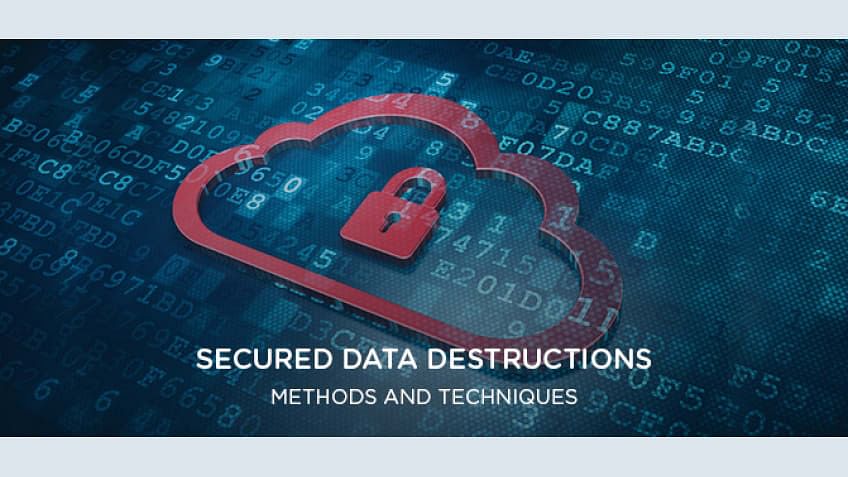Maximizing Cyber Security through Advanced Data Destruction Methods
Maximizing Cyber Security through Advanced Data Destruction Methods
Blog Article
Discovering the Importance of Information Damage in the Context of Computer System Protection Solutions and Protecting Confidential Information
In an age where data breaches are progressively typical, the value of efficient information damage can not be overstated. Organizations needs to take on strict steps to make certain that delicate info is not just protected during its lifecycle but likewise emphatically gotten rid of when no much longer required. The techniques employed for data obliteration, combined with compliance to lawful requirements, play an essential role in maintaining confidentiality and count on. The effects of these methods expand past plain conformity, affecting a company's online reputation and functional stability in the digital market. What techniques can organizations execute to boost their data damage procedures?
Understanding Data Destruction
Information devastation is a vital element of computer system safety that entails the long-term removal of information from storage space devices to stop unapproved accessibility and possible data violations. In an increasingly digital landscape, companies encounter heightened dangers associated with delicate details being improperly accessed or exploited. Reliable information devastation safeguards against these hazards, ensuring that confidential dataâEUR" such as customer information, intellectual home, and financial recordsâEUR" can not be recouped after disposal.
Recognizing the relevance of information destruction prolongs beyond plain compliance with legal and regulative structures; it is vital for maintaining organizational stability and depend on. When information is incorrectly taken care of or inadequately ruined, the repercussions can be extreme, including financial loss, reputational damages, and lawful obligations.

Approaches of Data Eradication

One widespread technique is information wiping, which includes overwriting existing information with random patterns multiple times. This technique renders the initial information irretrievable, making it a popular option for organizations seeking to shield personal information.
An additional approach is degaussing, which uses an effective electromagnetic field to disrupt the magnetic domains on storage gadgets, successfully getting rid of the information. This technique is particularly efficient for magnetic media yet is not suitable to solid-state drives.
Physical damage is another robust method, squashing or entailing the shredding of storage tools. This technique assurances that information recovery is essentially impossible, making it perfect for very delicate info.
Lastly, security can serve as a complementary approach to information elimination. By encrypting data prior to deletion, organizations can include an additional layer of safety, ensuring that even if residues are recouped, they stay inaccessible without the decryption trick. Each technique needs to be selected based upon the level of data sensitivity and the specific safety needs of the company.
Legal Conformity and Data Safety And Security
Organizations need to browse a complex landscape of legal needs associated to information safety and security, particularly after applying approaches of information obliteration. Various regulations, such as the General Information Security Guideline (GDPR) and the Medical Insurance Mobility and Responsibility Act (HIPAA), impose stringent standards on how companies need to handle and dispose of sensitive information. Failing to go to the website abide by these laws can bring about considerable lawful repercussions, consisting of significant fines and reputational damage.
Information destruction processes need to be diligently documented to demonstrate compliance with applicable legislations and criteria. This documentation not only offers as evidence of adherence to legal responsibilities however also highlights a dedication to safeguarding delicate info. Organizations needs to additionally develop clear policies concerning information retention and devastation timelines, making certain that data is not held longer than needed.

Additionally, regular audits and evaluations of data damage methods are necessary to maintain conformity and adjust to evolving lawful frameworks (data destruction). By proactively dealing with lawful needs, organizations can mitigate dangers related to data breaches and show their commitment to data safety and security. Ultimately, focusing on legal compliance in data devastation processes is not just a regulatory responsibility, however an essential facet of a robust data safety strategy
Impact on Organization Reputation
The online reputation of a company can be considerably influenced by its technique to data damage why not try here and administration. In today's digital landscape, where data breaches can occur anytime, the failure to properly dispose of delicate information can cause extreme consequences. Organizations that improperly handle data devastation risk exposing confidential consumer information, which not only violates personal privacy regulations yet likewise wears down depend on amongst customers and stakeholders.
A damaged reputation can result in decreased customer commitment, as customers end up being hesitant to involve with a company that has actually demonstrated negligence in securing their data. Negative promotion surrounding an information violation can have a long lasting result, as prospective customers might be hindered by the viewed lack of protection. This can bring about a direct decline in profits and market share.
Furthermore, services that prioritize data destruction as component of their protection technique can enhance their reputation by showcasing their dedication to securing delicate details. By embracing stringent data monitoring practices, organizations can not only mitigate dangers however also place themselves as credible entities in their corresponding markets, thereby strengthening their overall brand name image.

Finest Practices for Secure Disposal
Implementing best techniques for secure disposal of information is important for minimizing dangers related to information violations and making certain conformity with personal privacy regulations. Organizations must adopt a detailed data disposal plan that describes treatments for both electronic and physical information devastation.
For physical information storage gadgets, such as hard disks, shredding or degaussing is recommended to protect against data recuperation. Furthermore, organizations ought to maintain a chain of custody paperwork during the disposal procedure, making certain accountability and traceability of disposed items.
For digital data, making use of software program that sticks to industry standards click for info for information cleaning is essential. This software application should overwrite existing data multiple times, making healing virtually impossible. It is also crucial to confirm the efficiency of the data destruction process through audits or third-party assessments.
Educating workers on protected disposal techniques includes another layer of safety, as human error can often lead to information direct exposure. Routinely evaluating and upgrading disposal policies makes sure positioning with evolving guidelines and technical innovations. By implementing these ideal methods, companies can considerably lower the threat of unauthorized data gain access to and boost their general data defense strategy.
Final Thought
In verdict, information devastation is an essential aspect of computer safety services that makes certain the defense of secret information from unapproved accessibility. Implementing reliable methods of data obliteration, sticking to lawful compliance, and acknowledging the influence on company credibility are important elements of a thorough data safety approach. By taking on best practices for safe disposal, companies can foster trust fund with clients and guard sensitive information, ultimately adding to a much more protected electronic landscape.
In an age where information breaches are significantly usual, the value of efficient information damage can not be overemphasized.Data damage is a vital part of computer safety and security that entails the long-term elimination of information from storage space devices to avoid unapproved access and potential information violations. Organizations needs to also develop clear policies relating to information retention and destruction timelines, guaranteeing that information is not held longer than required.
By proactively attending to lawful needs, companies can alleviate threats connected with data breaches and show their commitment to data safety and security (data destruction). Eventually, focusing on lawful compliance in information devastation processes is not simply a regulative obligation, but a fundamental aspect of a robust data security strategy
Report this page